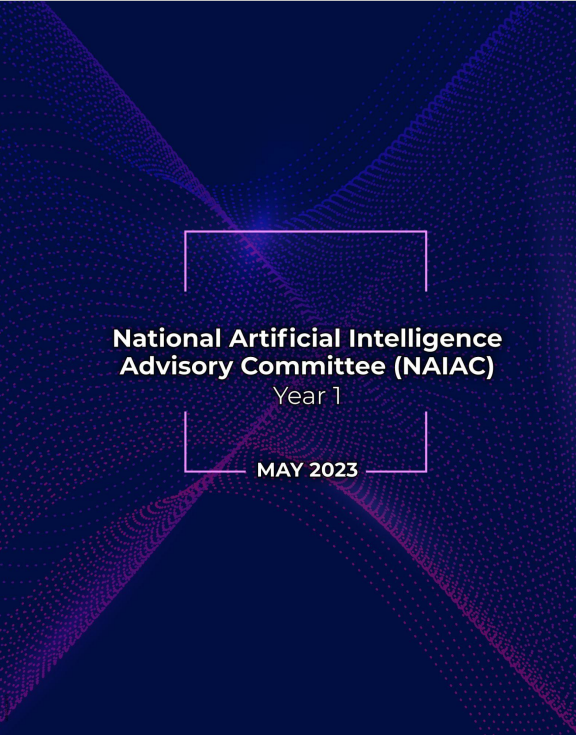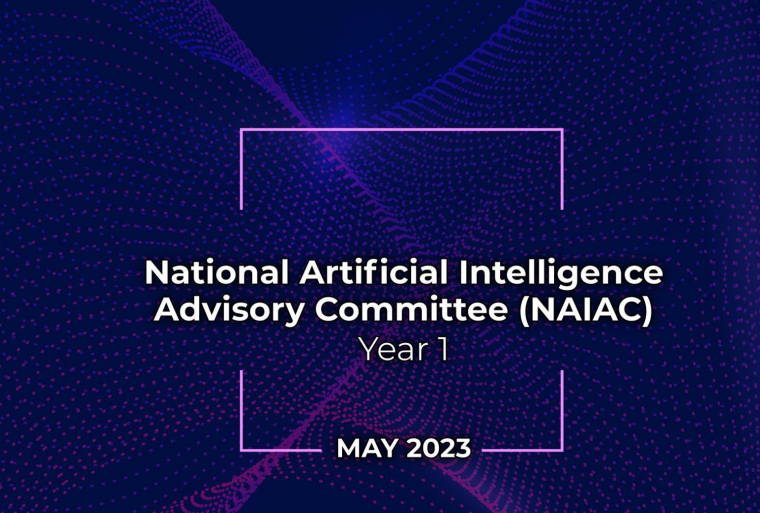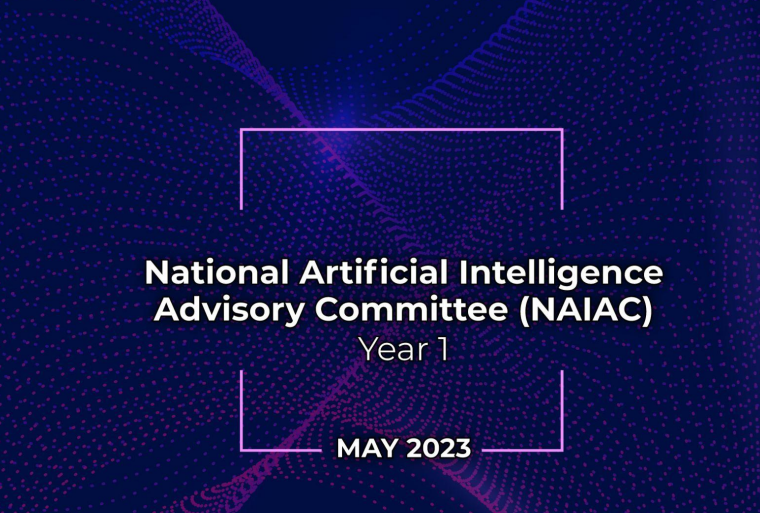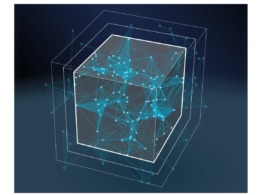HSI — Health Strategy Institute
multidisciplinary institute of continuous transformation for
in-person health and digital health strategy
Joaquim Cardoso MSc
Chief Research and Editor — of the Health Strategy Portal;
Chief Strategy Officer (CSO) — of the Health Strategy Institute (HSI),
Senior Advisor — for Boards and C-Level
June 23, 2023
Key Takeaways:
The National Artificial Intelligence Advisory Committee (NAIAC) released its first report to the president, supporting the Biden-Harris administration’s efforts in AI-related risks and opportunities.
- NAIAC established a Law Enforcement Subcommittee to address the use of AI in the criminal justice system.
- The committee plans to realign its working groups to explore the impacts of AI on workforce, equity, society, and more.
The report recommends steps for the U.S. government to maximize AI benefits while reducing harms, including
- bolstering leadership in trustworthy AI,
- R&D initiatives,
- international cooperation, and
- support for the workforce.
NAIAC will focus on rapidly developing areas of AI, such as generative AI.
- President Biden emphasizes mitigating AI risks to seize its opportunities, and NAIAC’s work aligns with the administration’s goal of responsible American innovation.
- The committee will consider mechanisms for faster work on AI development and deployment.
NAIAC’s new focus areas include
- AI futures, workforce impact, AI regulation, engagement and inclusion, generative AI safety, rights-respecting AI, international collaboration, AI procurement, and AI’s impact on the economy.
- NAIAC was created by the National AI Initiative Act of 2020 and is administered by the U.S. Department of Commerce’s NIST.
DEEP DIVE

National Artificial Intelligence Advisory Committee Releases First Report [USA]
NAIAC’s work supports the Biden-Harris administration’s ongoing efforts to advance a comprehensive approach to AI-related risks and opportunities.
June 22, 2023
The National Artificial Intelligence Advisory Committee ( NAIAC) has delivered its first report to the president, established a Law Enforcement Subcommittee to address the use of AI technologies in the criminal justice system, and completed plans to realign its working groups to allow it to explore the impacts of AI on workforce, equity, society and more.
The report recommends steps the U.S. government can take to maximize the benefits of AI technology, while reducing its harms. This includes new steps to bolster U.S. leadership in trustworthy AI, new R&D initiatives, increased international cooperation, and efforts to support the U.S. workforce in the era of AI. The report also identifies areas of focus for NAIAC for the next two years, including in rapidly developing areas of AI, such as generative AI.
“We are at a pivotal moment in the development of AI technology and need to work fast to keep pace with the changes it is bringing to our lives,” said U.S. Deputy Secretary of Commerce Don Graves. “As AI opens up exciting opportunities to improve things like medical diagnosis and access to health care and education, we have an obligation to make sure we strike the right balance between innovation and risk. We can lead the world in establishing trustworthy, inclusive and beneficial AI, and I look forward to considering the committee’s recommendations as we do that.”
When it comes to AI, President Biden has been clear that in order to seize the opportunities AI presents, we must first mitigate its risks. NAIAC’s work supports the Biden-Harris administration’s ongoing efforts to promote responsible American innovation in AI and protect people’s rights and safety.
Given the fast pace of development and deployment of AI technology such as generative AI, which includes the large language models that power chatbots and other tools that create new content, the committee also plans to consider various mechanisms for carrying out its work on short time frames in the coming years.
The committee recently completed plans to realign its working groups to allow it to explore the impacts of AI on workforce, equity, society and more.
The new NAIAC focus areas are:
- AI Futures: Sustaining Innovation in Next Gen AI
- AI in Work and the Workforce
- AI Regulation and Executive Action
- Engagement, Education and Inclusion
- Generative and NextGen AI: Safety and Assurance
- Rights-Respecting AI
- International Arena: Collaboration on AI Policy and AI-Enabled Solutions
- Procurement of AI Systems
- AI and the Economy
The full report, including all of its recommendations, is available on the AI.gov website. Join our mailing list to receive updates on committee activities.
The NAIAC was created by the National AI Initiative Act of 2020 to advise the president and the National AI Initiative Office in the White House Office of Science and Technology Policy. The authorizing statute called for a Law Enforcement Subcommittee, the membership of which was finalized in April 2023. The NAIAC is administered by the U.S Department of Commerce’s National Institute of Standards and Technology (NIST).
Originally published at https://www.nist.gov on June 22, 2023.
ORIGINAL PUBLICATION

EXECUTIVE SUMMARY
The United States is facing a critical moment: Artificial intelligence (AI) technology is rapidly accelerating in capability, and being deployed in more contexts with increasing use cases, both in the public and private realms. This is a moment of both significant opportunity and complexity. Our Committee has come into fruition at a time when our nation can and must position itself as a global leader in trustworthy, inclusive, and responsible AI.
The National Artificial Intelligence Advisory Committee (NAIAC) first convened in May 2022. NAIAC consists of 26 leading experts in AI (listed below) who have been tasked to advise the President and the White House National AI Initiative Office (NAIIO). Committee members have experience across a wide range of domains, from industry to academia to civil society. In their service on the NAIAC, Committee members provide expertise and actionable steps for AI policy and related activities — how we develop AI, govern it, and ensure it is equitably created, accessed, and deployed. This work is intended to guide the U.S. government in leveraging AI in a uniquely American way — one that prioritizes democratic values and civil liberties, while also increasing opportunity
This is the first formal NAIAC report, and covers the first year of our three-year appointment. The report is parsed into four major themes: (1) Leadership in Trustworthy Artificial Intelligence; (2) Leadership in Research and Development; (3) Supporting the U.S. Workforce and Providing Opportunity; and (4) International Cooperation.
Under each theme, the committee offers a number of objectives for engaging with AI, from the logistical (e.g., “Bolster AI leadership, coordination, and funding in the White House and across the U.S. government”) to the innovative (e.g., “Create an AI research and innovation observatory”). In total, NAIAC presents 14 objectives.
Because this report is intended to be actionable, objectives are tied to recommended actions. These actions entail creating and organizing federal AI leadership roles; standing up research and development initiatives; training civil servants in AI; increasing funding of specific programs; and more. In total, the NAIAC presents 24 actions.
Ultimately, this report frames AI as a technology that requires immediate, significant, and sustained government attention. The U.S. government must ensure AI-driven systems are safe and responsible, while also fueling innovation and opportunity at the public and private levels.
The report concludes with a look forward, explaining how the NAIAC will continue its work over the next two years — and help sustain the U.S. as a global leader in trustworthy AI

INTRODUCTION
Artificial intelligence (AI) can unlock significant opportunities for individuals, organizations, businesses, the economy, and society.
AI can fuel life-saving advances in healthcare, enhance educational training and workforce readiness, and facilitate the equitable distribution of opportunity. AI also powers many everyday products and services, and this is only likely to increase as the applicability and usefulness of AI advances. In the last few months alone, our awareness of and interest in AI in our daily lives has increased significantly. The release of powerful new AI technologies to the general public — such as Generative AI and Large Language Models (LLMs) — has opened eyes and imaginations to the potential and versatility of AI. We have seen that AI has the potential to power and propel the American economy by enabling innovation and productivity for a broader cross section of our population. AI also has the potential to help address many of society’s greatest opportunities and challenges. It can assist with scientific discovery in the health and the life sciences. It can help with climate science and sustainability. And it can help people today survive or avoid natural disasters, with innovations like wildfire and flood forecast alerts.
However, like many new technologies, AI also presents challenges and risks to both individuals and society.
For example, AI systems used to attract and retain talent in the workforce can expand opportunity, but could also amplify and perpetuate historical bias and discrimination at unprecedented speed and scale. Further, AI could be misused in harmful ways, such as spreading disinformation or engaging in cybercrime. AI systems could help enhance access, such as accommodating individuals with disabilities or linguistic barriers, or it could deliver incorrect diagnoses. AI could create economic opportunity or worsen the digital divide for individuals and communities. In the workforce, we are likely to see growth of new occupations and decline of others, as well as ongoing changes to many more occupations. All such challenges magnify the need for appropriate AI oversight and safeguards
The balance we establish in addressing these two divergent AI realities — fully harnessing its benefits while also effectively addressing its challenges and risks — will significantly impact our future.
If navigated appropriately, the U.S. government can ensure that AI creates greater opportunities, providing economic and societal benefits for a broader cross section of the population. However, if navigated poorly, AI will further widen the opportunity gap, and trustworthy AI for all may become an unrealized aspiration The importance of this moment extends beyond domestic borders, and the U.S. has an essential leadership role on the global stage in ensuring we understand and achieve trustworthy AI. The U.S. must proactively establish mandates and mechanisms to advance trustworthy AI and avoid ceding AI leadership to those entities with less equitable and inclusive goals.
The National Artificial Intelligence Advisory Committee (NAIAC) was created to advise the President on the intersection of AI and innovation, competition, societal issues, the economy, law, international relations, and other areas that can and will be impacted by AI in the near and long term.
Committee members hail from diverse backgrounds — academia, industry, civil society, government — and all possess deep and complementary expertise in AI.
Here, we present our year-one findings: high-level themes, our objectives, proposed actions, and a plan for future Committee activities.
Our goal is to help the U.S. government and society at large navigate this critical path to harness AI opportunities, create and model values-based innovation, and reduce AI’s risks. Our findings are grounded on core beliefs, such as: the establishment of safe and effective AI systems that are opportunity-creating and beneficial to society; there must exist robust defenses against algorithmic discrimination, including support for civil rights and civil liberties; data privacy is paramount; and people deserve to know if automated decision making is being used — and should always have a recourse like human intervention.
This report is divided into four thematic AI areas, based on our focused efforts over the past year, guided by the concerns listed in our statutory mandate including:
- Leadership in Trustworthy Artificial Intelligence,
- Leadership in Research and Development,
- Supporting the U.S. Workforce and Providing Opportunity, and
- International Collaboration.
Under each theme, we provide our broad objectives for U.S. leadership, and several, more granular recommended actions.
The content was developed by five working groups, with each NAIAC member serving on two working groups, and ultimately presenting the consensus of the full Committee.
There are several intended audiences for this report. In line with our congressional mandate, we write this report to advise the President and the White House in navigating AI policy. We also write for the Members of Congress, to whom we are grateful for the creation of NAIAC and for their continued support for our work, and for AI innovators and policymakers more generally. Finally, as noted in our first NAIAC meeting in May 2022, we will continue to engage a broad cross section of the population that includes underrepresented communities and geographically diverse regions. We will foster a national conversation on AI governance to better understand and achieve trustworthy AI. We will do this by creating ongoing dialogues, sharing our findings, and amplifying known and new experts in this space.
Originally published at ps://www.nist.gov












